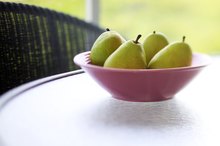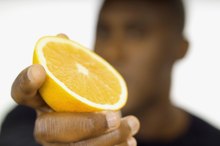What does fact checked mean?
At Healthfully, we strive to deliver objective content that is accurate and up-to-date. Our team periodically reviews articles in order to ensure content quality. The sources cited below consist of evidence from peer-reviewed journals, prominent medical organizations, academic associations, and government data.
The information contained on this site is for informational purposes only, and should not be used as a substitute for the advice of a professional health care provider. Please check with the appropriate physician regarding health questions and concerns. Although we strive to deliver accurate and up-to-date information, no guarantee to that effect is made.
What Is the Glycemic Index of Cranberries?
The glycemic index of a food tells you how rapidly it breaks down and is absorbed from the intestines into the bloodstream. Knowing the glycemic index of foods can help you maintain stable blood glucose levels. Stabilizing glucose levels helps you avoid diabetic complications if you have diabetes. It also can help you maintain your weight or lose weight if you have insulin resistance, often a part of Type 2 diabetes. Cranberries are part of a group of fruits with a medium glycemic index of 20 to 60, but no one has established the exact glycemic index for the fruit.
Determination
Carbohydrate-containing foods break down in the intestine and enter the bloodstream at different rates of speed. Simple sugars like glucose generally enter the bloodstream quickly. Glucose has an arbitrarily assigned glycemic index of 100, since it’s considered to be the most rapidly absorbed sugar. Foods with a lower glycemic index absorb more slowly. Fiber in cranberries and other fruits slows absorption, which results in a lower glycemic index.
- Carbohydrate-containing foods break down in the intestine and enter the bloodstream at different rates of speed.
- Fiber in cranberries and other fruits slows absorption, which results in a lower glycemic index.
Effects
Does Fruit Make Your Blood Sugar Go Up?
Learn More
Rapid absorption of glucose raises blood sugar very quickly, often to higher than normal levels. Spikes in blood glucose cause damage to blood vessels that lead to diabetic complications. More glucose stays in the bloodstream since cells don’t absorb it, increasing the risk of developing diabetes. A study found that unsweetened cranberry juice did not raise blood glucose levels any faster than water. The study, published in the 2008 issue of the “Journal of Medicinal Food” also found that glucose levels rose higher 30 minutes after subjects consumed normal-calorie cranberry juice, but returned to normal within three hours.
- Rapid absorption of glucose raises blood sugar very quickly, often to higher than normal levels.
- A study found that unsweetened cranberry juice did not raise blood glucose levels any faster than water.
Confounding Factors
Most people don’t eat cranberries plain, because they’re relatively sour. They’re often mixed in muffins or other baked goods, made in cranberry sauce or drunk as cranberry juice. Dried cranberries, often eaten like raisins, have added sugar. Juices made from cranberries and other fruits tend to have a higher glycemic index than the fruits themselves, since they usually have the fiber removed.
- Most people don’t eat cranberries plain, because they’re relatively sour.
- Juices made from cranberries and other fruits tend to have a higher glycemic index than the fruits themselves, since they usually have the fiber removed.
Considerations
Good Fruits for the Kidneys
Learn More
Cranberries have other health benefits besides a relatively low glycemic index; they also contain antioxidants, substances that reduce cellular damage that can lead to cancer, heart disease and other illnesses. To get the most benefit out of cranberries, choose cranberry products with the lowest glycemic index, such as cranberry bread made with whole grains and the least amount of added sugar, such as low-calorie cranberry juice.
Related Articles
References
- Harvard School of Public Health: Fiber
- Ojo O, Ojo OO, Adebowale F, Wang XH. The effect of dietary glycaemic index on glycaemia in patients with type 2 diabetes: A systematic review and meta-analysis of randomized controlled trials. Nutrients. 2018;10(3):373. Published 2018 Mar 19. doi:10.3390/nu10030373
- Glycemic Index and Diabetes. American Diabetes Association
- Search for the Glycemic Index. The University of Sydney
- Zeevi D, Korem T, Zmora N, et al. Personalized Nutrition by Prediction of Glycemic Responses. Cell. 2015;163(5):1079-1094. doi:10.1016/j.cell.2015.11.001+
- Sacks FM, Carey VJ, Anderson CA, et al. Effects of high vs low glycemic index of dietary carbohydrate on cardiovascular disease risk factors and insulin sensitivity: the OmniCarb randomized clinical trial. JAMA. 2014;312(23):2531-41. doi:10.1001/jama.2014.16658.
- Vega-lópez S, Venn BJ, Slavin JL. Relevance of the Glycemic Index and Glycemic Load for Body Weight, Diabetes, and Cardiovascular Disease. Nutrients. 2018;10(10). doi:10.3390/nu10101361
- Glycemic Index Database. University of Sydney. Updated October 13, 2020
- Eleazu C. O. (2016). The concept of low glycemic index and glycemic load foods as panacea for type 2 diabetes mellitus; prospects, challenges and solutions. African health sciences, 16(2), 468–479. doi:10.4314/ahs.v16i2.15
- Foster-Powell, Kaye, Holt, Susanna and Brand-Miller, Janette. "International table of glycemic index and glycemic load values: 2002." American Journal of Clinical Nutrition. 76,:1: 5-56 (2002).
- International Carbohydrate Quality Consortium, Jenkins, D. J., Willett, W. C., Astrup, A., Augustin, L. S., Baer-Sinnott, S., … Wolever, T. M. (2014). Glycaemic index: did Health Canada get it wrong? Position from the International Carbohydrate Quality Consortium (ICQC). The British journal of nutrition, 111(2), 380–382. doi:10.1017/S0007114513003905
- Leroux, MarcusFoster-Powell, Kaye, Holt, Susanna and Brand-Miller, Janette. "International Table of Glycemic Index and Glycemic Load Values: 2002." American Journal of Clinical Nutrition. Vol. 76, No. 1, 5-56, (2002).
- Lui, S., Willett, WC, et al. "A prospective study of dietary glycemic load, carbohydrate intake, and risk of coronary heart disease in US women.." American Journal of Clinical Nutrition. 71(6):1455-61. (2001).
- Mayer-Davis, E.J., Dhawan, A et al. "Towards understanding of glycaemic index and glycaemic load in habitual diet: associations with measures of glycaemia in the Insulin Resistance Atherosclerosis Study.." British Nutrition Journal. 95(2):397-405. (2006).
- Sacks, F. M., Carey, V. J., Anderson, C. A., Miller, E. R., 3rd, Copeland, T., Charleston, J., … Appel, L. J. (2014). Effects of high vs low glycemic index of dietary carbohydrate on cardiovascular disease risk factors and insulin sensitivity: the OmniCarb randomized clinical trial. JAMA, 312(23), 2531–2541. doi:10.1001/jama.2014.16658
- Salmeron, J, Manson, JE, et al. "Dietary fiber, glycemic load, and risk of non-insulin-dependent diabetes mellitus in women.." Journal of the American Medical Association. 12;277(6):472-7. (1997).
- Vega-López, S., Venn, B., & Slavin, J. (2018). Relevance of the Glycemic Index and Glycemic Load for Body Weight, Diabetes, and Cardiovascular Disease. Nutrients, 10(10), 1361. doi:10.3390/nu10101361
- Zeevi, D. Korem N. et al. Personalized Nutrition by Prediction of Glycemic ResponsesCell. 163:(5):1079-94. November 2015.
Writer Bio
A registered nurse with more than 25 years of experience in oncology, labor/delivery, neonatal intensive care, infertility and ophthalmology, Sharon Perkins has also coauthored and edited numerous health books for the Wiley "Dummies" series. Perkins also has extensive experience working in home health with medically fragile pediatric patients.









